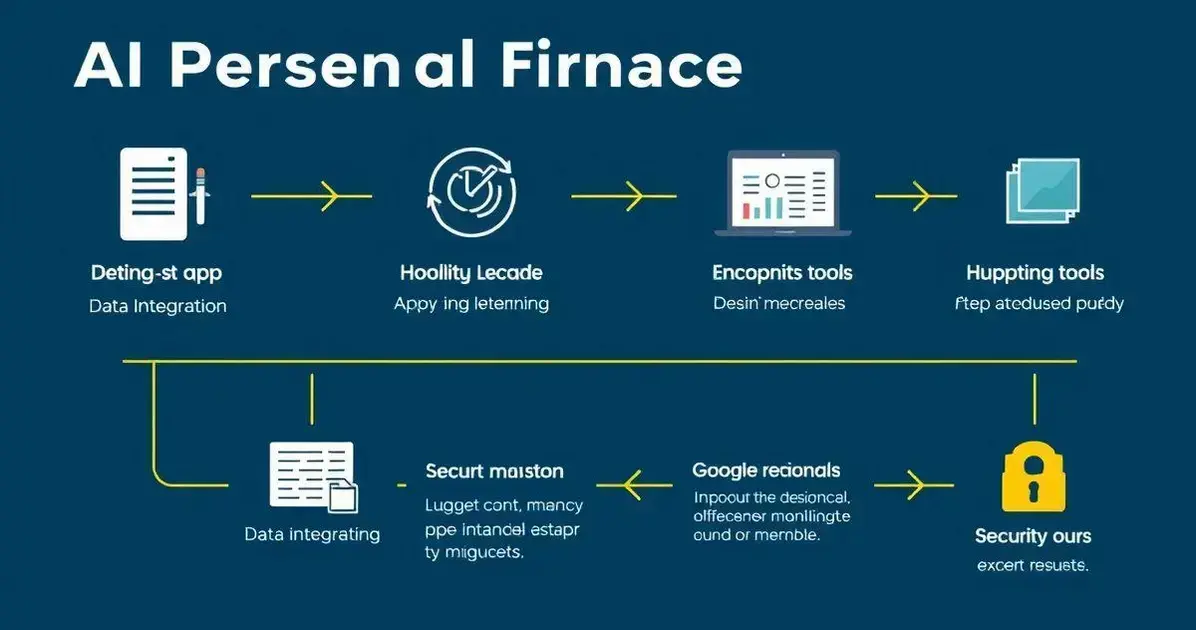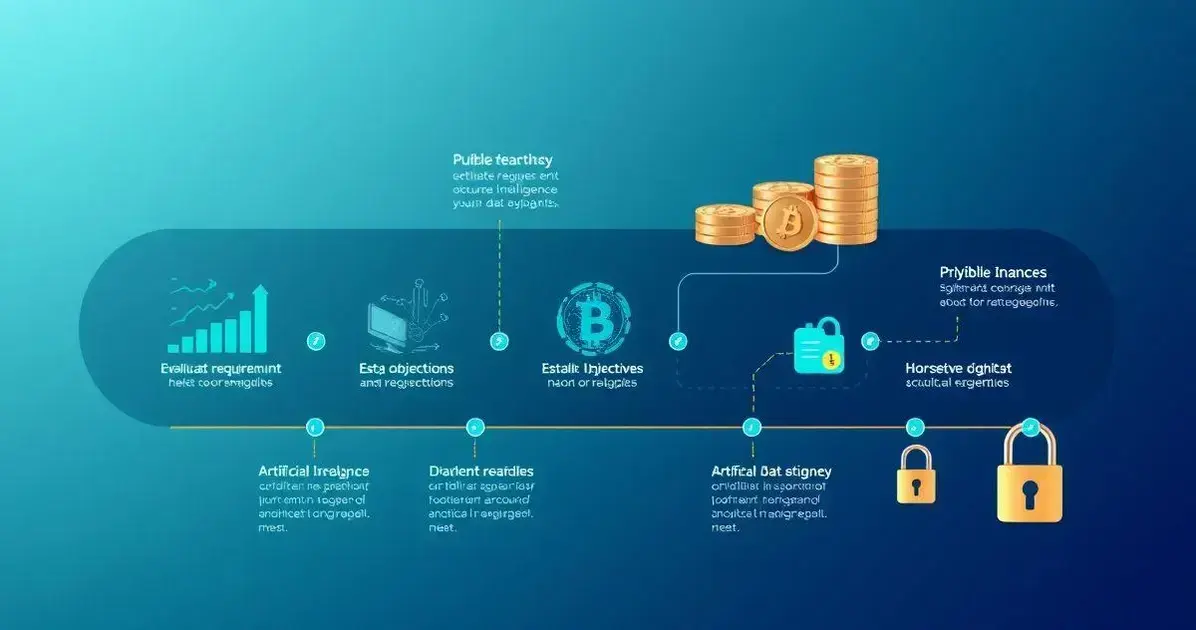AI personal finance app are digital tools that use artificial intelligence to optimize your money management. They analyze your financial data and provide personalized insights, helping you make more informed decisions about spending, saving, and investing.
These apps connect to your bank accounts and, using advanced algorithms, track your spending habits. They then offer precise recommendations to help with financial control, adjusting according to your behavior.
If you want to learn how these tools can improve your financial health and simplify money management, keep reading!
What is an AI Personal Finance App?
An AI personal finance app is a digital tool that uses artificial intelligence to help users manage their money. These apps analyze your financial data, offer personalized insights, and provide recommendations to improve your financial situation. By utilizing advanced algorithms, they can forecast spending, suggest savings plans, and even assist with investment strategies.
Key Features
Many AI personal finance apps come with features such as expense tracking, budget creation, and automated savings. They often sync with your bank accounts, making it easy to see your entire financial picture in one place. Additionally, some apps use machine learning to adapt to your spending habits, providing tailored advice that grows with you.
Examples of AI Personal Finance Apps
Popular AI personal finance apps include Mint, YNAB (You Need a Budget), and Personal Capital. Each of these apps integrates AI technology to enhance how users interact with their finances. They help you stay on track with your budget while identifying areas for improvement.
Understanding the Importance
The rise of AI personal finance apps reflects a growing need for efficient and effective money management tools. In today’s fast-paced world, these apps make it simple to take control of your finances. Whether you want to save for a vacation or pay off debt, they offer solutions tailored to your unique financial goals.
Benefits of Using AI in Personal Finance
Using an AI personal finance app brings several valuable advantages that can enhance your financial management. Here are some of the key benefits:
Enhanced Budgeting
AI helps create budgets tailored to your income and spending habits. It analyzes past transactions and offers suggestions on where to cut back, making budgeting easier and more accurate.
Automated Savings
One of the standout features of AI personal finance apps is automated savings. By analyzing your cash flow, these apps can recommend specific amounts to save each month and even set up automatic transfers to your savings account.
Personalized Financial Insights
AI algorithms provide insights based on your financial patterns. This means you receive advice that’s customized just for you, whether that’s on saving strategies, investment opportunities, or debt repayment.
Real-Time Expense Tracking
AI apps track your spending as it happens. This helps you stay informed about where your money goes, making it easier to identify unnecessary expenses and adjust your habits accordingly.
Financial Goal Setting
With the aid of AI, setting and monitoring financial goals becomes seamless. Whether it’s saving for a house or retirement, these apps can help you visualize your progress and keep you motivated.
Investing Guidance
Some AI personal finance apps offer investing insights, recommending investment options that fit your risk tolerance and financial goals. This guidance can help you grow your wealth effectively over time.
Improved Security
AI can enhance your financial security by providing alerts for any unusual transactions. This proactive approach helps protect you from fraud and unauthorized spending.
With all these benefits, using an AI personal finance app can significantly improve your financial health, enabling you to make informed decisions that pave the way for financial freedom.
How AI Personal Finance Apps Work

AI personal finance apps use advanced technology to manage and analyze your financial data efficiently. Here’s how they work:
Data Integration
First, these apps connect to your bank accounts and credit cards. They gather data about your spending habits and income. This process helps the app build a complete picture of your financial life.
Machine Learning Algorithms
AI personal finance apps use machine learning algorithms to analyze this data. These algorithms identify patterns in your spending. They can predict future expenses based on previous data, allowing you to plan effectively.
Personalized Recommendations
Once the app has analyzed your financial data, it offers personalized recommendations. For example, it may suggest ways to save money, reduce spending, or better invest your funds. This advice is tailored specifically to you, increasing its effectiveness.
Budgeting Tools
AI tools are also designed to create budgets based on your habits and goals. They set automatic reminders to help you stick to these budgets. This feature ensures you consistently manage your finances well.
Expense Tracking
Real-time expense tracking is another key function. As you spend, the app categorizes your purchases. You can quickly see how much you have left in your budget for each category, making it easier to control your finances.
Automatic Insights and Alerts
AI personal finance apps provide insights and alerts about your financial health. For instance, they can notify you if you are nearing your budget limits or if an unusual transaction occurs. This information helps you stay informed and proactive.
Security Measures
To protect your data, these apps use encryption and secure connections. This ensures your information remains safe while managing your finances, giving you peace of mind.
In summary, AI personal finance apps simplify money management through data integration, machine learning, and personalized features, helping users achieve financial freedom.
Comparing Popular AI Personal Finance Apps
When it comes to AI personal finance apps, there are several popular options available, each with unique features. Here’s a comparison of three leading apps:
Mint
Mint is one of the best-known personal finance apps. It offers free budgeting tools and expense tracking. Users can connect their bank accounts for automatic updates. Mint provides insights into spending patterns, bill tracking, and credit score monitoring. The app is user-friendly, making it a good choice for beginners.
YNAB (You Need A Budget)
YNAB is designed with the zero-based budgeting method in mind. This app helps users allocate every dollar they earn to specific expenses or savings goals. YNAB focuses on teaching budgeting skills and offers educational resources. It has a subscription fee but appeals to users who want an interactive budgeting experience.
Personal Capital
Personal Capital concentrates on investment tracking and retirement planning. It offers financial tools that help you analyze your net worth and plan for long-term financial goals. While it includes budgeting features, its primary strength lies in investment management. The core features are free, but users may encounter upselling for financial advisory services.
Features Comparison
Below are some key features of each app:
- Mint: Free, connects to bank accounts, expense tracking, budgeting, credit score review.
- YNAB: Subscription-based, zero-based budgeting, educational resources, personalized goal setting.
- Personal Capital: Free features, investment tracking, retirement planning, net worth analysis.
Choosing the right app depends on your individual financial needs and goals. Some users prefer comprehensive budgeting, while others might focus more on investments.
Tips for Choosing the Right AI Finance App
Choosing the right AI finance app is essential for effective money management. To help you make an informed decision, here are some valuable tips:
1. Identify Your Financial Goals
Before selecting an app, clarify what you want to achieve. Whether it’s budgeting, saving, or investing, knowing your goals helps narrow down your options.
2. Evaluate Features
Different apps offer various features. Look for tools that cater to your specific needs, such as expense tracking, budgeting templates, or investment options. Review how each app aligns with your financial goals.
3. Consider User Experience
The usability of an app is important. Choose an app with an easy-to-navigate interface. A good user experience will help you stay engaged and consistent with your money management.
4. Check for Compatibility
Ensure the app is compatible with your devices and bank accounts. Many apps allow syncing with multiple bank accounts, which enables a complete view of your finances.
5. Read Reviews and Ratings
Research user reviews and expert ratings. These can provide insights into the app’s reliability, security, and overall performance.
6. Look for Security Features
Protecting your financial information is crucial. Choose apps that offer robust security measures, such as encryption and two-factor authentication.
7. Trial Versions
Many apps offer free trials. Take advantage of those trials to explore the app’s features without any commitment. This will help you determine if it suits your needs.
8. Pricing and Subscription Plans
Some finance apps are free, while others charge subscription fees. Assess the value of features relative to the cost. Choose an app that offers the best return on investment for your financial management.
By following these tips, you can select an AI finance app that not only meets your requirements but also enhances your money management experience.
Integrating AI into Your Financial Strategy

Integrating AI into your financial strategy can enhance your decision-making and improve your financial outcomes. Here are some key steps to effectively incorporate AI into your planning:
1. Assess Your Financial Needs
Before you start using AI tools, evaluate your current financial situation. Identify areas where you need improvement, such as budgeting, saving, or investing. This will help you select the right AI tools that align with your financial goals.
2. Set Clear Financial Goals
Establish clear and achievable financial goals. Whether you aim to save for retirement or pay off debt, having explicit goals allows AI tools to provide tailored suggestions and strategies to reach those objectives.
3. Choose the Right AI Finance Apps
Research and choose AI finance apps that best fit your needs. Look for apps that offer features like budgeting, tracking investments, and providing financial insights. Ensure they are user-friendly and integrate well with your existing financial accounts.
4. Automate Routine Tasks
Utilize AI to automate routine financial tasks. Set up automatic savings transfers or bill payments. Automating these tasks can save you time and ensure you never miss important deadlines.
5. Monitor and Adjust Regularly
Continuously monitor your financial progress and the effectiveness of the AI tools you are using. Regularly review your financial plans and make adjustments as needed based on the insights provided by AI.
6. Leverage Data Insights
AI can analyze data to help you understand spending habits and investment opportunities. Use these insights to make informed decisions and stay aligned with your financial strategy.
7. Stay Educated
Keep yourself informed about the latest developments in AI technology. Attend webinars, read articles, or take courses to enhance your understanding of how AI can further aid your financial strategy.
8. Ensure Security and Privacy
When integrating AI into your financial planning, prioritize data security. Choose applications that offer strong security measures to protect your financial information from unauthorized access.
By thoughtfully integrating AI into your financial strategy, you can optimize your financial management and work towards achieving your long-term financial goals more effectively.
The Future of AI in Personal Finance
The future of AI in personal finance looks bright and full of exciting possibilities. As technology continues to evolve, so will the role of AI in managing money and financial planning.
1. More Personalized Financial Advice
In the coming years, AI tools will become even more sophisticated at analyzing user data. This means that financial advice will be more tailored to individual needs, making it easier for users to achieve their financial goals.
2. Enhanced Predictive Analytics
AI will improve its ability to predict market trends and user behavior. This capability can help users make better investment decisions and prepare for future expenses. By understanding how markets react, users can optimize their portfolios effectively.
3. Increased Integration with Banking
As banks and financial institutions adopt AI technologies, users can expect seamless integrations between their bank accounts and personal finance apps. This will provide a more holistic view of personal finances and simplify management.
4. Greater Focus on Financial Wellness
AI will shift from simply providing financial management tools to focusing on overall financial wellness. Users will have access to tools that help them understand their spending habits, build healthy financial behaviors, and set achievable financial goals.
5. Advanced Security Measures
With the increasing use of AI, security features will also advance. AI can identify unusual activities and potential security threats quickly, offering stronger protection for users’ financial data.
6. Efficient Saving and Budgeting
Future AI applications will automate budgeting and saving even further. Users can expect apps that autonomously adjust budgets based on spending patterns and savings goals, ensuring they stay on track without manual input.
7. AI-Driven Financial Education
AI can provide personalized learning experiences, helping users understand complex financial concepts. Through interactive tutorials and recommendations, people will become more financially literate.
8. Ecosystem for Investments
AI will create comprehensive ecosystems for investments by integrating various services within one platform. Users will be able to manage their investments, track performance, and receive insights in one place.
As AI continues to advance in the personal finance sector, it will empower users to take control of their financial futures, improve decision-making, and simplify the complexities of managing money.
User Experiences with AI Personal Finance Apps
User experiences with AI personal finance apps can vary widely, reflecting the diverse needs and preferences of different users. Here are some common experiences and feedback from users:
1. Ease of Use
Many users appreciate the intuitive interfaces of AI personal finance apps. The simple navigation makes budgeting and tracking expenses straightforward. Users often mention how easy it is to set up their accounts and start using the app.
2. Personalized Recommendations
Users often report enjoying personalized financial advice. By analyzing spending habits, these apps provide tailored suggestions for improving savings and investments. This personalized approach can motivate users to follow through on their financial goals.
3. Automation Benefits
Automation features are a hit among users. With automatic bill payments and savings transfers, users find it easier to manage their finances without the worry of forgetting important payments. This feature receives positive feedback for simplifying cash flow management.
4. Insightful Data Analytics
AI personal finance apps offer users valuable insights into spending patterns. Many users find the visual representations of their finances, such as charts and graphs, helpful for understanding their financial health at a glance.
5. Addressing Security Concerns
While many users feel secure using AI personal finance apps, potential security concerns still arise. Some report worries about data privacy and sharing their financial information. Most apps address these issues by implementing strong security measures, helping to build trust among users.
6. Customer Support Experiences
User experiences with customer support can vary. While many apps provide responsive and helpful customer service, some users report delays or difficulty resolving issues. This can impact overall satisfaction with the app.
7. Integration with Other Services
Users frequently value the ability to connect multiple bank accounts and investment portfolios. This integration allows for a comprehensive view of overall finances, making it easier to manage different assets.
8. Continuous Improvement
Feedback from users often highlights the need for continuous updates and new features. Many users appreciate when developers actively listen to user feedback and roll out updates to improve functionality and user experience.
Overall, user experiences with AI personal finance apps reveal a mix of positive feedback and areas for improvement. As these apps continue to evolve, users can expect even better tools for managing their finances.
The Transformative Power of AI in Personal Finance
Integrating Artificial Intelligence (AI) into personal finance offers vast potential for improving financial management. From personalized advice to automated savings, AI personal finance apps empower users to take control of their financial futures.
As these apps continue to evolve, they will provide even more insightful analytics, enhanced security, and seamless integration with financial institutions.
User experiences highlight the benefits of ease of use and the valuable insights these tools offer. However, ongoing improvements and security measures are essential to maintaining user trust and satisfaction.
In conclusion, adopting AI in personal finance is not just a trend; it’s a significant shift that can lead to better decision-making and financial wellness. Embracing these tools can ultimately pave the way toward achieving financial freedom.


